Clarion Houses in North East Lancashire
1. Narrative history of Colne Clarion House
The Colne Clarion House was established in 1911 when the Colne Independent Labour Party purchased the former Farmers' Tavern, or Farmers' Arms, at Shelfield in the Great Marsden district of Nelson. As is shown on the following map, the building is about 1044 feet above sea-level. The map was based on a survey of 1892 and published in 1895.
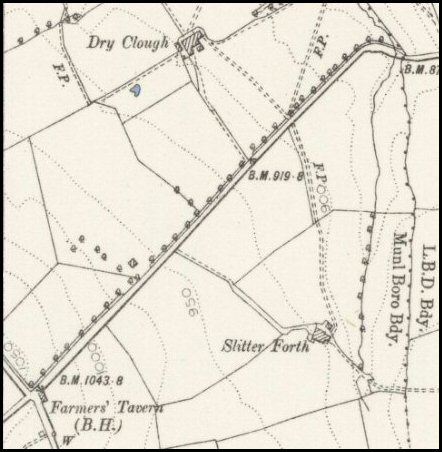
Since 1903 the term Clarion House had been used by the Nelson I.L.P. for its property near Roughlee: the Colne I.L.P. may have followed its example. Although the Colne building ceased to be a Clarion House in the 1950's it is still marked as such on modern-day maps, as on the map below.

At the time of the 1841 population census the building was occupied by three households. The head of each household was described as a cotton weaver: all three were probably weaving by hand under the domestic system. Two of the households were probably accommodated in the main part of the building: one household in the front and the other in the back. The third household was probably living in the extension to the house that can be seen in the following photograph, which was possibly taken in the 1910's. Note the three chimneys.
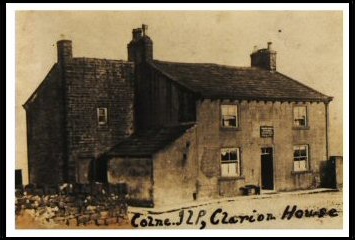
The second photograph is a recent one taken from the rear of the building. The chimney on the extension is no longer there.
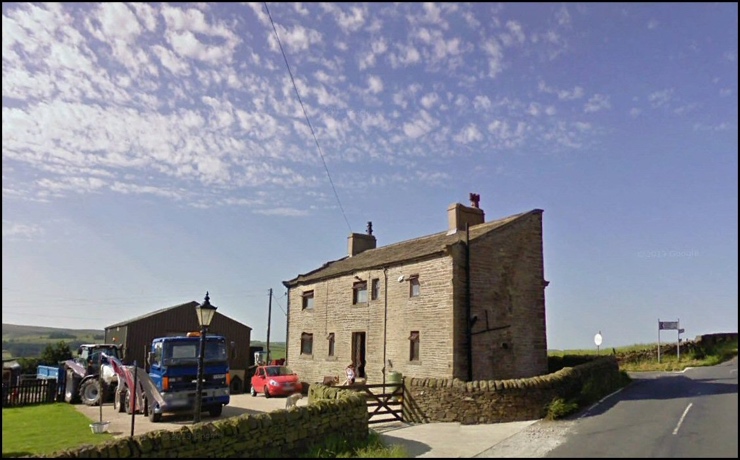
By the time of the 1851 census one of the 1841 household heads, Blakey Nutter, had become a shop keeper. Ten years later he was described as a beer seller of Shelfield Beer House. Moving forward in time to 1881 the building was occupied by only a single household. Its head was a William Duerden, a beer seller who, perhaps significantly, was born in the village of Barrowford. In both the 1891 and 1901 census returns the building was described as the Farmers' Tavern.
An advertisement in the 22 July 1882 issue of the Burnley Express revealed that the Farmers' Arms [sic] at Shelfield was owned by the Clough Spring Brewery of Barrowford.

Six years later the Clough Spring Brewery was taken over by John Kenyon Ltd. of Clough Fold in the Forest of Rossendale.
On 9 March 1910 the Burnley Express published a short article relating to the General Gordon Inn in Great Marsden. The article reported that 'Mr. Snowden, the licensee of the Farmers' Tavern, was called before the magistrates, and the Clerk said, "You understand you are not to have a renewal of your license after next February." Mr. Snowden replied in the affirmative, and the magistrates said the licence would be granted on the terms laid down.'
The head of the household at the Farmers' Tavern in April 1911, the month the census was taken, was Benjamin Snowden, clearly the same Mr. Snowden who was mentioned in the article in the previous year's Burnley Gazette . He was born in 1864 in Cowling, a village about six miles from Colne. Also born in Cowling in the year 1864 was the politician Philip Snowden. Philip was the chairman of the I.L.P. during the periods 1903-1906 and 1917-20 and, as reported in the 26 November 1919 issue of the Burnley Express , was the I.L.P. nominee for the parliamentary seat of Nelson and Colne in the 'forthcoming vacancy in the Division.'

An article in the 12 May 1911 issue of the Tomorden and District News reported that 'the Todmorden Clarion [Cycling] Club run on Saturday last was . . . to Colne I.L.P Club-house, which is about a mile from Trawden.' It appears, therefore, that the Colne I.L.P. acquired the Farmers' Tavern during the early months of 1911. A possible link between Benjamin Snowden and Philip Snowden may have played a part in the acquisition.
The Burnley Express reported on 17 July 1918 that a meeting of the Nelson and Colne Parliamentary Borough Labour Party had taken place at the Clarion House, Nelson on Sunday 'under the auspices of the Colne Branch of the I.L.P.' As was noted above, the Colne I.L.P. Clarion House at Shelfield was within the Great Marsden district of Nelson.
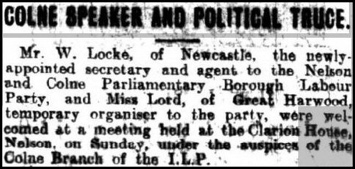
In 1932 the I.L.P. disaffiliated itself from the Labour Party and this precipitated a massive decline in membership. Between 1932 and 1935 the membership fell from nearly 17,000 to just over 4,000. This decline in numbers probably had a major impact on the Colne I.L.P.
In 1937, as reported in the 3 May issue of the Lancashire Evening Post , the Colne Clarion House was acquired by the Nelson and Colne Divisional Labour Party. It was opened by Sydney Silverman MP. The ownership of the house by the Colne I.L.P. had lasted just twenty-six years.
An advertisement in the 6 July 1951 issue of the Nelson Leader showed that the Clarion House at Shelfield was now under the 'New Management' of a Mrs F. Metcalfe.
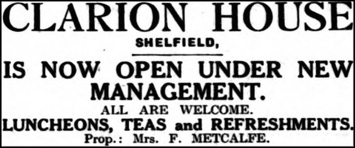
In the following year the 16 May issue of the Barnoldswick and Earby Times reported that members of the Colne and Nelson Holiday Fellowship were planning to visit the Colne Clarion on 17 May 1952. Significantly, the same newspaper, in its issue of 27 March 1953, contained an advertisement for Shelfield Cafe (Late Colne Clarion).
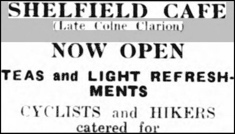
Despite this apparent demise, a "Clarion House" Cafe was advertised for sale in the Nelson Leader issue of 8 May 1953. This cannot have been the Burnley I.L.P Cottage at Clough Croft near Roggerham or the Nelson I.L.P. Clarion House near Roughlee. Therefore it must have been the former Colne Clarion House at Shelfield.
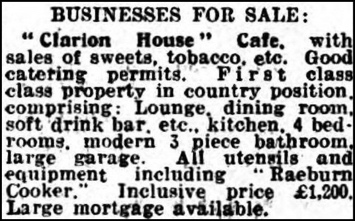
The sign over the door in the following photograph appears to be dominated by the word Cafe. It is possible that this photograph was taken in connection with the proposed sale.
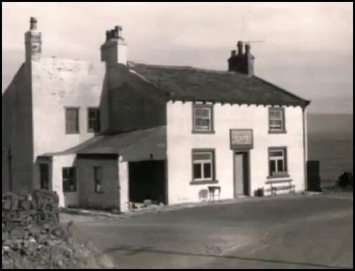
The 1 October 1954 issue of the Nelson Leader reported that an 'observation and novelty trial' held by the Colne and District M.C. finished at Shelfield Cafe. In December the family of Frederick and Connie Pilkington was living there. The family must have purchased the cafe in response to the 1953 advertisement, as they had been resident for about eighteen months. The Pilkington children included a son named Garry aged 7 and a daughter named Gail aged 6. The Nelson Leader issue of 10 December 1954 described how the two children had experienced an epic journey home from school as a result of deep lying snow. Living at Shelfield in the winter was clearly not an easy way of life in the 1950's, as Mrs. Pilkington made abundantly clear.

The cafe probably closed for the last time in the mid-1950s. Today (2007) it is simply a private dwelling.
2. Notes on the Ribble Valley Clarion Clubhouse
This was opened in 1913 by the North Lancashire Union of the National Clarion Cycling Club. It was located near Ribchester, at Higher Madgell Bank in Clayton-le-Dale.
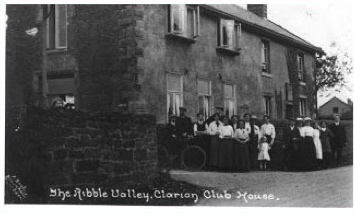
In common with earlier Clarion CC clubhouses, such as Bucklow Hill in Cheshire (opened in 1897) and its successor at nearby Handforth (1903), the house offered accommodation together with space for camping. These pre-1914 clubhouses were the forerunners of the Youth Hostelling Association. By 1939 only three of them remained: Ribble Valley; Oversley Ford in Cheshire, not far from Styal, which replaced Handforth in 1936; and Chevin End, near Menston, opened by the Yorkshire Union of Clarion Cycling Clubs in 1908.
By the end of WW II the nature of the house had clearly changed. The 22 November 1946 issue of the Nelson Leader provided details of the Nelson Clarion CC's forthcoming run.
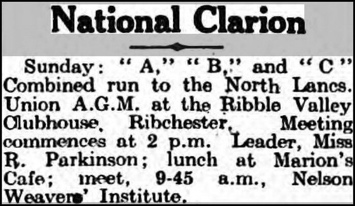
Marion's Cafe was located adjacent to a sharp bend in the road about half a mile south of the Clarion House. Normally the cyclists would have taken lunch at the Clubhouse.
An advertisement in the Barnoldswick and Earby Times of 12 April 1946 had shown that the building was now a guest house and no longer a Clarion Clubhouse.

By the 1970's the building had been converted into a pub and night club for young people and re-named the Lodestar.
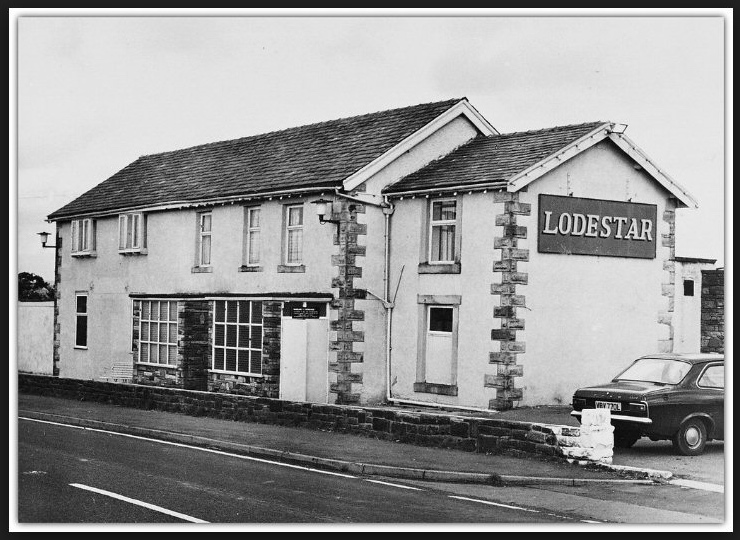
Eventually the Lodestar was closed and purchased by the owner of the neighbouring property, Oak Mount. It was then modernised, extended, and given the name Oak View.
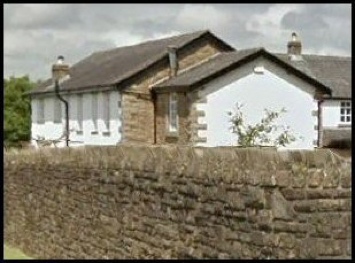
3. Notes on the Nelson I.L.P. Clarion House
This is the last remaining Clarion House in the country and was the first to be established of the five Clarion Houses in north-east Lancashire. It has an excellent website:
http://www.clarionhouse.org.uk/index.htm
It is located in Roughlee Booth and is the successor to two earlier buildings in the area that were rented by the Nelson I.L.P. The first was a small cottage in Thorneyholme Square, opened in 1899. The second was Nabs Farm, opened in 1903: it was labelled a Clarion House, perhaps following the example of the Clarion CC clubhouses in Cheshire.
In 1910 the Nelson I.L.P. Land Society was formed and this led, with help from the Nelson Weavers' Association, to the building of the present Clarion House on land owned by the Society in Jinney Lane, Dimpenley Clough.
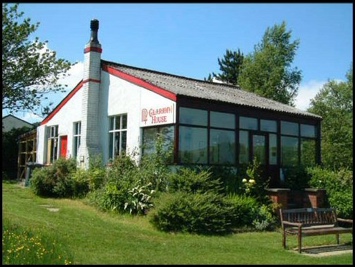
The house was opened in 1912, and the ceremony was reported in the 2 November issue of the Burnley Express .
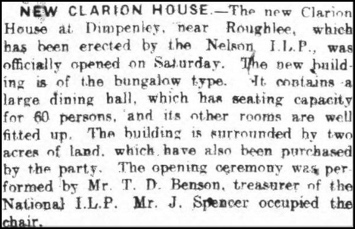
4. Notes on the Burnley I.L.P. Clarion House
Between 1884 and 1905 a man named Tattersall Wilkinson had provided a series of refreshment rooms in the Roggerham district of Briercliffe-with-Extwistle [1]. It seems likely that members of the Burnley I.L.P. would have patronised his establishments. One of the establishments was at Clough Croft where Tattersall was living in 1891. By 1916 Tattersall had settled at nearby Lea Green and the Burnley I.L.P. had acquired Clough Croft. A report in the 10 June 1916 issue of the Burnley News reported that a conscientious objector who was an absentee from the Army Reserve had been apprehended 'at Clough Croft Cottage, Roggerham, which was owned by the I.L.P.'
However, the Burnley I.L.P. does not appear to have fully owned the cottage until 1927, as was reported in the 19 November issue of the Burnley News .

In 1933, the year after the I.L.P. had disaffiliated itself from the Labour Party, the ownership of the cottage was in dispute. A lengthy letter written to the Burnley Express from Thompson Harker of the Roggerham Socialist Fellowship, and printed in the 6 May issue, claimed that the Burnley branch of the I.L.P. 'has neither moral nor legal right to ownership of the property. The I.L.P. has no moral right to it because the bulk of the people who found the money for the purchase of the property have left the I.L.P., because it deserted the main principle upon which it was founded. The I.L.P. have no legal right to the cottage and land because it was transferred at a properly constituted meeting according to its own rules, to the Roggerham Socialist Fellowship.' The Fellowship decided, however, to waive its claim, although an advertisement in the 24 March 1945 issue of the Burnley Express appeared to echo the dispute.

Advertisements or announcements by the occupiers or owners of the building rarely, if ever, referred to it as a Clarion House: the most frequent name given to it was simply the I.L.P. Cottage at Roggerham. It appears to have been only cyclists and ramblers who used the term Clarion House to describe it, probably because of its similarity to the other I.L.P. Clarion Houses in the Burnley area (Colne and Nelson) and to Clarion Houses further afield such as Ribble Valley.
In the 6 January 1956 issue of the Nelson Leader an announcement appeared that probably spelled the end of the Burnley I.L.P. Cottage.
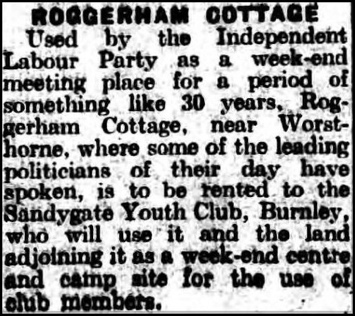
One of the politicians of his day who spoke at the cottage was Philip Snowden. The 7 July 1917 issue of the Burnley Express announced he would be speaking at the cottage as part of a Garden Party and Demonstration [against the war].
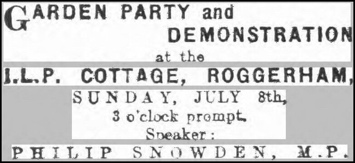
Today (2018) the cottage is in ruins.

5. Notes on the Nelson and Colne S.D.F. Clarion House
The following announcement appeared in the 27 June 1903 issue of Justice, the weekly newspaper of the Social Democratic Federation:

This house was a very short-lived affair. In the Burnley Gazette of 3 May 1905 was a report on an application by the Nelson and Colne branches of the Social Democratic Federation to eject a tenant from a property in Briercliffe, owned by the branches, known as Robin Houses.

A month later the 3 June 1905 issue of Justice carried a notice by the Nelson and Colne S.D.F. which advertised the opening of its new Clarion House at Briercliffe:

A map of 1913 shows the property as Clarion House, not Robin Houses, with Hollin Grove to the west and Burwains to the east:
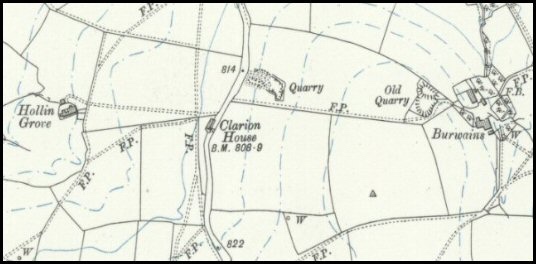
On earlier maps the building is named Hanging Fields.
In 1913 a man named Seth Sagar and his wife Alice moved to Nelson from Padiham. Seth soon joined the local branch of the S.D.F. with its headquarters in Ann Street. He recalled in his memoirs that 'Alice and I, with the other members would go to Robbins Cottage, situated well in the country and on Saturday evenings there would be potato pie and social evening and on Sunday many people took their food when tea was provided.' Seth also recalled that he 'walked to Ribchester Ribble Valley [from Padiham], when Robert Blatchford opened the Clarion House at Ribchester' [2].
The Burnley Express of 2 February 1919 contained the following advertisement.

Clearly the Nelson and Colne S.D.F. had been affected in a major way by the First World War and had decided to close its Clarion House.
Robin Houses or Cottages were still popular with walkers and others in the late 1940s as the following report in the Barnoldswick and Earby Times of 1 October 1948 confirms.
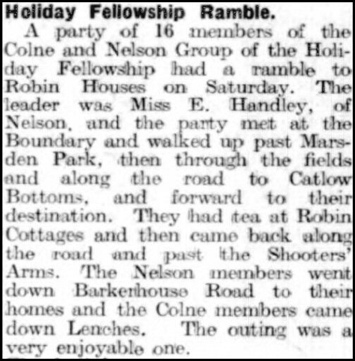
The cottages are still there today in Robin House Lane.
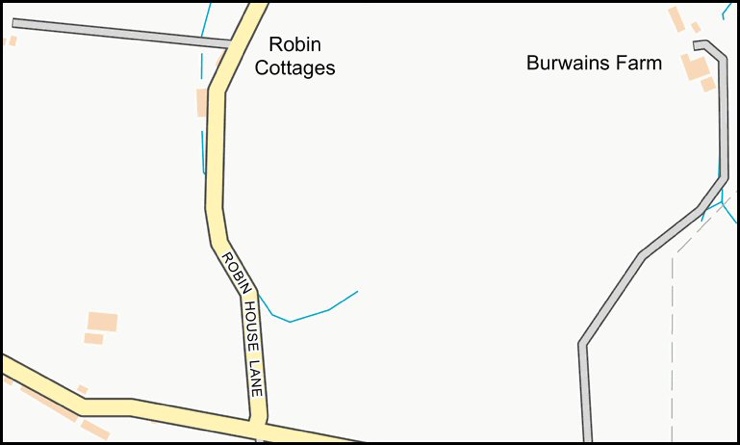
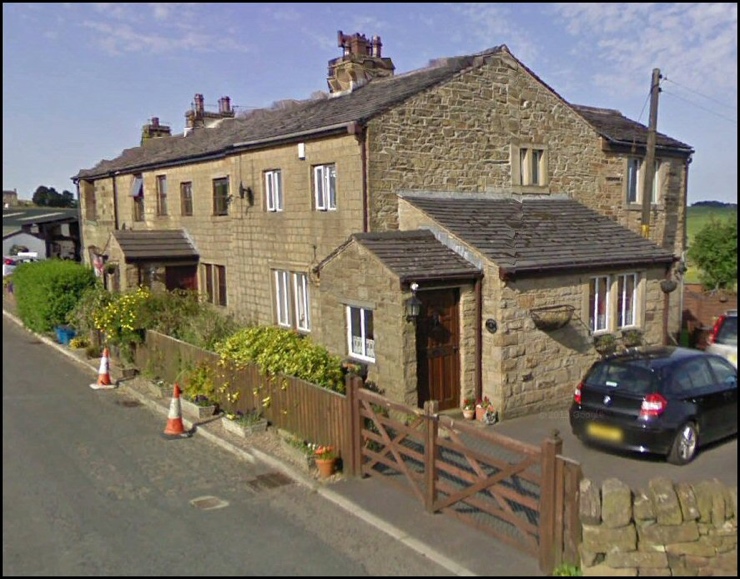
Notes
1. For Tattersall Wilkinson see Ken Spencer, Tattersall Wilkinson: A Very Remarkable Man (Briercliffe: The Briercliffe Society, 1987).
2. Seth Sagar, "Memoirs [Part I]" in Labour's Turning Point in the North West: 1880-1914 (Southport: North West Labour History Society, 1984), pp. 51-58. Reprinted in North West Labour History 33 (2008-9), pp. 15-19